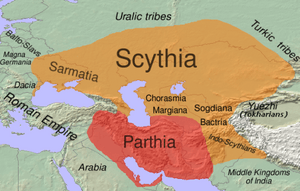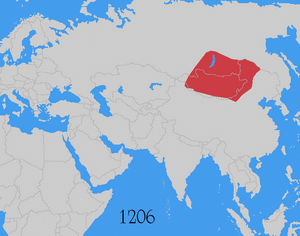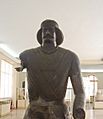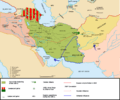History of Iran facts for kids
Iran is a country with a very long history, going back about 6,000 years! It's home to one of the world's oldest civilizations. Around 625 BC, a group called the Medes united the area, creating a powerful empire.
A big change happened between 633 and 656 AD when Islamic armies conquered Persia, ending the Sassanid Empire. For many centuries, Iran was ruled by a king called a Shah. This continued until 1979, when a revolution changed Iran into an Islamic Republic. This officially happened on April 1, 1979.
Contents
Ancient History of Iran

Before Iran was called Iran, and before Iranians lived there, a different group of people lived in the land. These people were called the Elamites. They are even mentioned in the Bible! The Elamites lived in a kingdom called Elam.
The Elamites became weak after fighting the Assyrian people for a long time. Because of this, Iranian peoples, like the Medes, were able to conquer Elam. The Iranians then went on to conquer the Assyrians too.
The Name Iran
The name Iran comes from the word Aryan. This word is also found in the ancient book of the Zoroastrians, called the Avesta. In the Persian language, Iran means "Aryan".
In the 19th and early 20th centuries, Europeans used the name Aryan to mean all Indo-Europeans.
Great Empires of Ancient Iran
Around 500 BC, the area that is now Iran was the center of the powerful Persian Empire. Later, Alexander the Great conquered the country through fighting. After his rule, the Achaemenid dynasty of Persia ruled again for a time.
Then, the Sassanian dynasty took over, ruling from 224 to 651 AD.
Islamic Iran
Over time, other groups of people conquered parts of Persia through fighting. These included the Arabs in the 7th century, Turks in the 10th century, and Mongols in the 13th century. However, Iran always kept its own unique culture and managed to survive as a distinct nation.
The Safavid Dynasty
The Safavid dynasty (1502-1736) made Islam and Shi'a Islam the official state religion of Iran. Islam was already very popular there by then.
Modern History and the Shah
The most recent kings of Iran were from the Pahlavi dynasty. They ruled from 1925 until 1979. In 1979, there was a revolution, and Ayatollah Khomeini created an Islamic republic.
In 1951, Mohammad Mossadegh became prime minister of Iran after being elected by almost all members of the Majlis (Iran's parliament). His first action was to take control of Iran's oil industry. Before this, the oil industry had been controlled by Great Britain. At that time, most of Britain's oil came from Iran.
Britain saw this move as a danger to its security and empire. They tried to overthrow the Iranian government but failed. After this, they convinced the United States that the Iranian government was a communist threat.
The CIA worked in Iran to create riots. These riots led to Prime Minister Mossadegh being removed from power. The United States and Great Britain then helped the Shah Mohammad Reza Pahlavi become King of Iran again.
The Islamic Republic
The Shah ruled Iran for 38 years. When he left Iran, the Iranian government was changed to an Islamic Republic by the Islamic Revolution.
Soon after, Iranian students, with the support of the new government, took over the U.S. Embassy in Tehran. They held most of the diplomats hostage for 444 days. Relations between the two countries have not been good since then. For example, the US has placed different types of economic sanctions against Iran.
The US claims that Iran supports terrorist groups against Israel. Iran does not recognize Israel as a state. Iran, along with most Arab countries, believes that Israel does not have the right to occupy the land of Palestinians.
Iran and Its Neighbors
Iran shares long borders with Iraq. (The words "Iran" and "Iraq" look similar in the Latin alphabet, but they are written differently in Arabic and Persian.) Iranians are ethnically not Arabs.
Iran defended itself against an Iraqi invasion in 1980. This war lasted eight years. Many Arab and Western countries, including the United States, provided weapons (including biological and chemical weapons) and technical support to Iraq's Saddam Hussein.
Nuclear Technology
Now, some Western countries are trying to stop Iran from developing nuclear technology. This is even though Iran is a member of the NPT (a treaty about not spreading nuclear weapons). These countries say they are worried that Iran wants to develop nuclear weapons.
The IAEA has reported many times that there is no proof Iran is developing nuclear weapons. However, it also says it cannot be completely sure that Iran is not doing so in secret. A CIA report from December 2007 claimed that Iran's secret program to get nuclear weapons technology was stopped in 2003 and has not restarted since. It also reported that Iran's ability to build a nuclear weapon probably won't happen soon.
Recent Elections
The presidential elections on June 13, 2009, were officially won by the existing president, M. Ahmadinejad. However, some people did not believe these results were true. There were demonstrations because of these results, and some protesters fought with police. Many people who demonstrated thought the election was a fraud. Officially, nine people died during these protests.
Images for kids
-
Chogha Zanbil is one of the few ancient ziggurats outside of Mesopotamia.
-
A panoramic view of Persepolis.
-
The Seleucid Empire in 200 BC.
-
Bronze Statue of a Parthian prince, National Museum of Iran.
-
Rock-face relief at Naqsh-e Rustam showing Iranian emperor Shapur I capturing Roman emperors.
-
Hunting scene on a gilded silver bowl showing king Khosrau I.
-
Battle between Heraclius' army and Persians under Khosrow II, fresco by Piero della Francesca.
-
The Saffarid dynasty in 900 AD.
-
Babak Khorramdin was the leader of the Khurramīyah movement.
-
Eurasia on the eve of the Mongol invasions, c. 1200.
-
Imam Reza shrine, the tomb of the eighth Imam of the twelver Shiites.
-
Forensic facial reconstruction of Timur.
-
The Aq Qoyunlu confederation at its greatest extent.
-
The Safavid Empire at its greatest extent.
-
Როსტომ ხანი.gif
Rostom of Kartli, viceroy of Kartli, eastern Georgia.
-
Persian Cossack Brigade in Tabriz in 1909.
-
Tehran men celebrating the 1953 Iranian coup d'état.
-
Ayatollah Khomeini returns to Iran after 14 years in exile.
-
Mohammad Khatami, reformist President of Iran from 1997 to 2005.
-
The tomb of Cyrus the Great.
-
Mihr 'Ali. Portrait of Fath-Ali Shah Qajar.
-
Qajar era currency bill with depiction of Naser al-Din Shah Qajar.
-
A map of Iran under the Qajar dynasty in the 19th century.
See also
 In Spanish: Historia de Irán para niños
In Spanish: Historia de Irán para niños












































